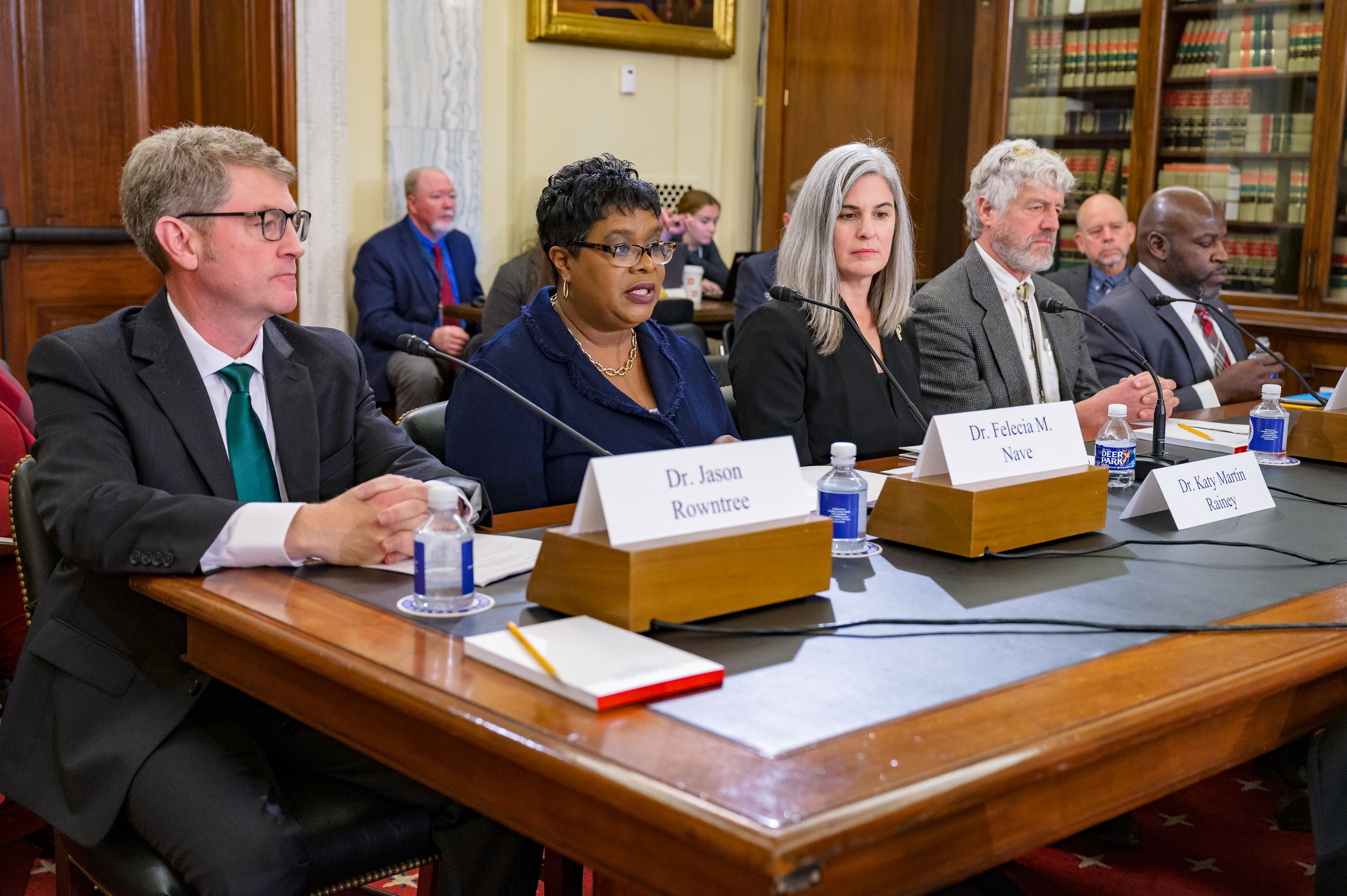Rowntree testifies before Senate Ag Committee in support of research, Extension funding
C.S. Mott Professor of Sustainable Agriculture Jason Rowntree appeared before the U.S. Senate Committee on Agriculture, Nutrition and Forestry to support funding for the 2023 Farm Bill


WASHINGTON, D.C. – Michigan State University C.S. Mott Professor of Sustainable Agriculture Jason Rowntree testified before the United States Senate Committee on Agriculture, Nutrition and Forestry on Dec. 6. Rowntree discussed the key role federal funding plays in his research and Extension programs and how those programs benefit agricultural stakeholders in Michigan and across the country.
Rowntree, co-director for the MSU Center for Regenerative Agriculture, was among various academic and agricultural leaders speaking on behalf of funding for the 2023 Farm Bill.
View video of Rowntree's testimony from C-SPAN.
Full Testimony from Dr. Rowntree
"Chairwoman (Sen. Debbie) Stabenow, Ranking Member (Sen. John) Boozman, and distinguished members of the committee. Thank you for your work and for the opportunity to testify about the importance of Cooperative Extension and Agriculture Research Funding. My name is Jason Rowntree and I serve as the C.S. Mott Chair of Sustainable Agriculture and co-director of the Center for Regenerative Agriculture at Michigan State University. My research relies heavily on federal agricultural research funding – in fact, I’ve led or been a co-investigator on research encompassing more than $27M from the USDA Sustainable Agriculture Research and Education Program (SARE), USDA National Institute of Food and Agriculture (NIFA) and the Foundation for the Future of Agriculture (FFAR). Most recently, I pioneered a $19.2M FFAR soil health grant entitled, 'Metrics, Management and Monitoring. An Investigation of Pasture and Rangeland Soil Health and its Drivers.'
The United States has the most efficient agricultural system globally. Technological advancements and intensification have enabled greater crop yields and improved animal productivity. However, these intensive practices have come with environmental costs such as greenhouse gas emissions, water contamination, and the erosion of our most prized agricultural resource: soil.
Soil losses endanger agricultural resilience by increasing drought vulnerability, reducing productivity, and releasing CO2 into the atmosphere. These challenges coupled with global unrest and a growing population places immense pressure on our agriculture resilience. Today, now more than ever before, domestic food security is inseparable from national security. And our national security hinges on our long-term climate security.
Investing in extension and agriculture research is a powerful and straightforward way to ensure we develop innovative solutions to these challenges. Further, we must envision holistic solutions well suited to address the complexity of agriculture. In my experience, the philosophy of regenerative agriculture is well suited to this challenge.
At the MSU Center for Regenerative Agriculture, we define regenerative agriculture along NRCS’s 5 soil health principles: keeping soils continuously covered, minimizing soil disturbance, increasing biological diversity, keeping living roots in the soil, and integrating livestock. While implementation varies by farm, practices aligned with these principles are associated with promising soil health and carbon sequestration outcomes while reducing inputs and not sacrificing profitability.
Importantly, this movement is farmer and rancher led. Just this week I watched a YouTube video of a farmer who is growing 200-bushel corn in western KS with no nitrogen or phosphorus application. This is the growing ‘culture’ in Agriculture. As these producers experiment and learn from one another, there is a need for Extension to help troubleshoot, educate, empower, and facilitate. Supporting and expanding Extension in this way is crucial to the success of regenerative agriculture as a climate solution. Experimental and on-farm research is equally important to this mission. Participatory research – where academics connect with on-the-ground producers – is essential.
The USDA SARE Program is well suited to this mission, however, there is a large gap between the demand for these projects and available funding. In my experience, only ~10% of farmer and academic led sustainability grants are successfully funded, while half the submissions were worthy of funding. Expanding participatory research impact is also feasible for USDA NIFA and FFAR.
Lastly, with the advent of natural capital markets (such as soil C offsets), research is desperately needed to facilitate the accurate and efficient quantification of ecosystem services.
The Natural Capital Project at Stanford University indicate that the first law of a successful natural capital market is that the transaction must yield the desired effect.
Essentially when a company purchases a CO2 offset, there must be proof that the offset is grounded in real soil carbon sequestration. A handshake doesn’t count. This requires rigor, accuracy, and robust accounting protocols that help us do things like avoid double-counting.
In the landmark document, “A National Strategic Narrative”, three core components were emphasized for future national security: Land, Energy, and Water. In the face of a changing climate, nothing could be truer today. With the known challenges to agriculture’s future, the question that must be posed, and especially thinking of our younger generations, is what level of food security risk do we assume by not acting? The easy bet is that continued and increased investment in Extension and Research will work to ensure we regenerate our food production system, mitigate climate risk and enhance national security for future generations.
Thank you again for the opportunity to address the committee and I look forward to any questions."



 Print
Print Email
Email




